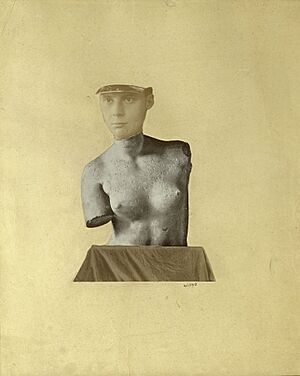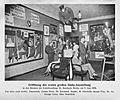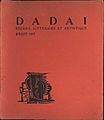Dadaism facts for kids
Dadaism was an exciting and rebellious art movement that started around World War I. Imagine a group of artists, writers, and thinkers who felt that the world had gone a bit crazy because of the war. They decided that if the world didn't make sense, then their art shouldn't either!
So, Dadaism was all about poking fun at the serious, traditional ways of art and life. It wanted to show how meaningless and absurd the modern world seemed to them. This movement was most active from 1916 to 1922. Even though it was short-lived, Dadaism had a huge impact. It influenced many later art styles, like surrealism, pop art, and even punk rock.
Dada artists loved to go against normal social rules and expectations. They believed in freedom, creativity, and challenging everything. Famous Dada followers included Antonin Artaud, Max Ernst, and Salvador Dalí. Years later, in the 1960s, a new version called Neo-Dada appeared, inspired by the original movement.
Contents
What Was Dadaism All About?
Dadaism was more than just an art style; it was a way of thinking. Artists felt that the old ways of society and art had led to the terrible war. They wanted to create something completely new and different. They used humor, nonsense, and shock to make people think.
Why Did Dada Start?
The First World War (1914-1918) was a very difficult time. Many young people were sent to fight, and millions died. Artists and writers saw the destruction and felt that the world had lost its mind. They believed that logic and reason, which society valued so much, had failed.
So, they decided to reject logic. They wanted to create art that was chaotic, funny, and sometimes even offensive. It was their way of protesting the war and the society that allowed it to happen. They wanted to shake people up and make them question everything.
Where Did Dadaism Begin?
Dadaism officially began in Zürich, Switzerland, in 1916. Switzerland was neutral during World War I, so many artists and intellectuals from different countries gathered there. They met at a nightclub called the Cabaret Voltaire. Here, they put on wild performances, read strange poems, and showed their unusual art.
From Zürich, Dadaism spread to other major cities around the world. These included Berlin and Cologne in Germany, Paris in France, and New York City in the United States. Each city added its own flavor to the movement.
How Did Dada Artists Create?
Dada artists used many different ways to express themselves. They didn't stick to traditional painting or sculpture. They liked to experiment and surprise people.
Collage and Photomontage
One popular technique was collage. This is where artists glue different materials, like newspaper clippings, photos, and fabric, onto a surface. Dada artists used collage to create chaotic and thought-provoking images. They often cut up pictures from magazines and newspapers to make new, strange scenes.
A special type of collage was photomontage. This involved cutting and pasting photographs together. Artists like Hannah Höch and Raoul Hausmann were masters of photomontage. They used it to criticize society and politics in a very direct way.
Readymades: Everyday Objects as Art
Perhaps the most famous Dada idea was the "readymade." This was invented by the artist Marcel Duchamp. A readymade is an ordinary object that an artist chooses and presents as art. Duchamp believed that simply choosing an object and giving it a title could make it art.
His most famous readymade was Fountain (1917). It was a urinal that he signed with the name "R. Mutt" and submitted to an art exhibition. This shocked the art world! It made people question what art really was and who decided what counted as art.
Performance and Poetry
Dada artists also loved to perform. At places like the Cabaret Voltaire, they would put on wild shows. These might include:
- Reading poems that sounded like nonsense.
- Wearing strange costumes.
- Making loud, chaotic music.
- Dancing in unusual ways.
Their performances were meant to be shocking and to challenge the audience. They wanted to break down the barrier between the artist and the audience.
Dada poetry was also very experimental. Poets like Tristan Tzara would sometimes cut up newspaper articles and rearrange the words randomly to create poems. This was another way to reject traditional rules and embrace chance.
Important Dada Artists
Many talented artists were part of the Dada movement. Here are a few key figures:
- Marcel Duchamp (French): Known for his "readymades" and for challenging the very definition of art. He made people think about the idea behind the art, not just the skill.
- Hannah Höch (German): A pioneer of photomontage. Her works often explored gender roles and political issues in post-war Germany.
- Man Ray (American): A photographer and filmmaker who created surreal and experimental works. He often used everyday objects in his photographs in surprising ways.
- Tristan Tzara (Romanian/French): A writer and poet who was one of the founders of Dada in Zürich. He wrote many of the manifestos (statements of beliefs) for the movement.
- Francis Picabia (French): An artist who moved between different styles, including Cubism and Surrealism. His Dada works often featured strange machine-like drawings and playful titles.
The End of Dada and Its Legacy
By the mid-1920s, the original Dada movement started to fade. Many of the artists moved on to other styles. Some of them, like Max Ernst and Salvador Dalí, became important figures in Surrealism. Surrealism was a new movement that grew directly out of Dada's ideas, but it focused more on dreams and the unconscious mind.
Even though Dadaism was short-lived, its impact was huge. It taught artists to be brave, to question authority, and to experiment with new forms and ideas. It showed that art doesn't always have to be beautiful or logical; it can also be rebellious, funny, and thought-provoking. Many modern art movements owe a lot to the bold spirit of Dada.
Images for kids
-
Grand opening of the first Dada exhibition: International Dada Fair, Berlin, 5 June 1920. The central figure hanging from the ceiling was an effigy of a German officer with a pig's head. From left to right: Raoul Hausmann, Hannah Höch (sitting), Otto Burchard, Johannes Baader, Wieland Herzfelde, Margarete Herzfelde, Dr. Oz (Otto Schmalhausen), George Grosz and John Heartfield.
-
Francis Picabia: left, Le saint des saints c'est de moi qu'il s'agit dans ce portrait, 1 July 1915; center, Portrait d'une jeune fille americaine dans l'état de nudité, 5 July 1915; right, J'ai vu et c'est de toi qu'il s'agit, De Zayas! De Zayas! Je suis venu sur les rivages du Pont-Euxin, New York, 1915
-
Cover of the first edition of the publication Dada, Tristan Tzara; Zürich, 1917
-
Francis Picabia, Dame! Illustration for the cover of the periodical Dadaphone, n. 7, Paris, March 1920
-
Hannah Höch, Cut with the Kitchen Knife through the Last Epoch of Weimar Beer-Belly Culture in Germany, 1919, collage of pasted papers, 90×144 cm, Nationalgalerie, Staatliche Museen zu Berlin
-
Rrose Sélavy, the alter ego of Dadaist Marcel Duchamp
-
Marcel Duchamp, Fountain, 1917; photograph by Alfred Stieglitz
-
Man Ray, c. 1921–22, Rencontre dans la porte tournante, published on the cover of Der Sturm, Volume 13, Number 3, 5 March 1922
-
The Janco Dada Museum, named after Marcel Janco, in Ein Hod, Israel
See also
 In Spanish: Dadaísmo para niños
In Spanish: Dadaísmo para niños

















